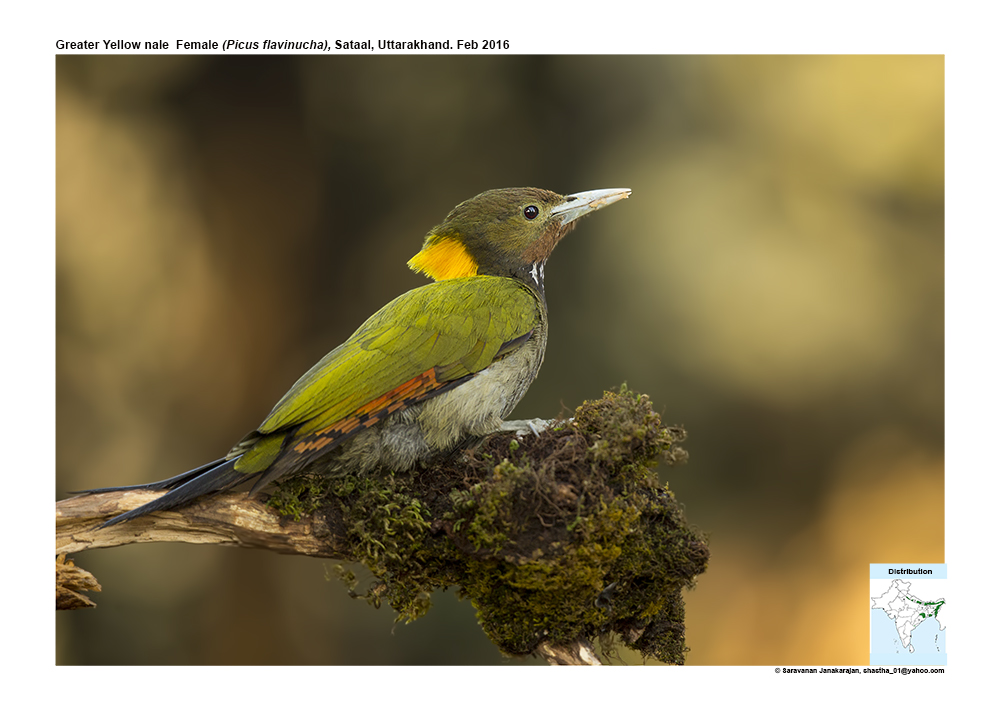Greater Yellow Nape

Greater Yellownape Woodpecker Picus flavinucha
Etymology:
- Picus : Latin word for Woodpecker; Greek Mythology Picus, king of Latium, who married the beautiful nymph and songstress Canens and was changed into a woodpecker by the spiteful Circe, whose affections he had spurned
- Flavinucha : Latin word flavus – yellow; nuchus –
Vernacular Names: Cachar: Daoja gadaiya, Lepcha: Mong kli ong
Distribution in India: Resident of Western Himalayas in India.
Description: Size of 32–35 cm; Wt. of 153–198 g. The male has olive-green forehead and crown, feathers are tipped rufous-brown when fresh, and tips of elongated hindcrown feathers and nape are bright golden-yellow, this colour continuing down hindneck. It has dark olive-green lores and ear-coverts, blacker rear neck side; bright yellow chin and throat, lower throat feathers are blackish with white edges. It has bright yellowish-green upperparts, tertials with rufous barring on inner webs; primaries and secondaries are dark green, outer primaries are blackish-brown, all broadly barred rufous on both webs. The uppertail is blackish; upper breast is olive-black, rest of underparts is greenish-grey; underwing is brownish and barred paler. The undertail is blackish-brown, outer feathers are washed greenish. It has a long bill with slightly chisel-tipped, variably curved culmen, fairly broad across nostrils, broad at base and dark grey. The iris is brownish-red or reddish, orbital ring is grey to greenish or blue-grey. The legs are green-grey or grey. The female is less bulky, shorter-billed than male, yellow of chin and throat is replaced by rufous-brown. The juvenile is duller than adult, crest is less golden, greyer below, eyes are brown, male with buff-yellow throat occasionally spotted dark, rufous colour in malar, sometimes some red feather tips in crown, female as adult but less rufous on throat.
Habitat: It is found in open evergreen and deciduous forests with tall trees, oak and sal forests, mixed forest, pine forest, and secondary growth. It is found from lowlands up to 2750 m.
Food habits: It eats ants and termites, and large insect larvae, like wood-boring beetles, centipedes, frogs, nestlings of other hole-nesting species, berries and seeds. It is shy and restless, occurs in pairs and in family groups and also commonly with various species of Drongos, babbler and bulbul. It prefers to forage on trunks and branches of small to large trees, but exploits all levels of forest; rarely forages on ground. It moves rapidly on smaller branches, and perches crosswise. All foraging techniques are directed to the surface; gleaning, reaching, sweeping away debris, and probing, are common; excavating, or even single pecks are rare.
Breeding habits: They breed in Mar–Jun in Indian Subcontinent, from Feb in SE Asia, and Apr–May in Sumatra. The breeding displays include crest-raising combined with head-lifting with bill upwards. The nest-hole is excavated by both sexes. They lay a clutch of 2–4 eggs. The incubation is done by both parents. Both parents also share brood-feeding.